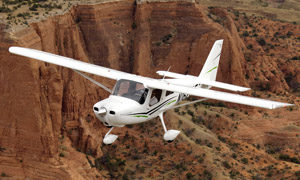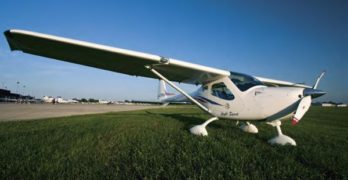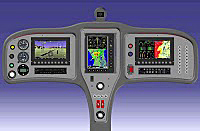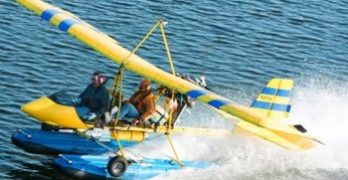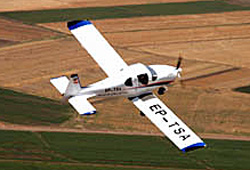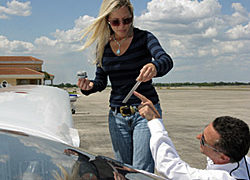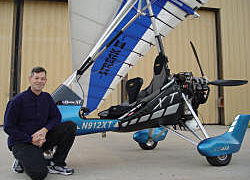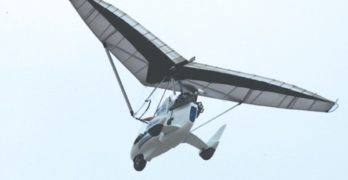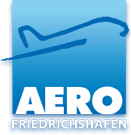In that rarified air of the executive suite, well… at least in the boss’ office of LSA companies, something seems to be happening. Think about this question for a moment: What do the following LSA have in common? — Skycatcher, SeaRey, Paradise P1, Remos GX, and PiperSport. Give up? OK, it was something of a trick question. The answer: All the companies supplying these LSA have gone through major management changes in 2011. *** The most widely reported departure was that of Jack Pelton, who held the titles of President, CEO, and Chairman at Cessna. Along with him went other notables like Tom Aniello and John Doman; the latter man was VP of piston sales for years; he’s at Flight Design now. So besides Cessna’s very deep cuts to employment (previously media reports have said that more than 50% of workers were laid off), now top management has also changed.
Search Results for : flight design ct
Not finding exactly what you expected? Try our advanced search option.
Select a manufacturer to go straight to all our content about that manufacturer.
Select an aircraft model to go straight to all our content about that model.
Up-And-Comer… Remos GX
New Remos GX Rises
An LSA that was 10 years in
the making may aptly be
called a “mature design”
within this nascent sector
of piston aircraft. A few others
share a similarly “ripe, old” heritage,
but most are far newer than the trusty GA
models in which many of us learned the
art of flying.
Designed by engineer Lorenz Kreitmayr,
the first Remos G-3 took to the air
in 1997 (10 years before the upgraded GX
first flew). In 2008, N447RA, the first GX,
arrived in the States for the big summer
flyfest in Oshkosh, and that’s where I had
a chance to update my Remos experience
(previously earned in the G-3). Assisting
and educating me were two Remos reps:
National Technical Service Manager Cris
Ferguson and Managing Director of Sales
and Marketing Michael Meirer.
What’s The Difference?
While G-3 sold more than 250 copies,
performing well for European pilots for
years, the arrival of the U.S.
What Comes Next After the Remos GX?
Remos arrived in America with their G-3 model. In 2008 the company upgraded to GX. What’s next? How about the GX NXT. Did you see that coming? *** Remos Aircraft sent out advance word that its new GX NXT will debut at Oshkosh this year. The current GX Aviator II model will not be replaced. The German company’s new NXT version reflects a new instrument panel and price (base: $129,961, a significant drop from the Aviator II). *** Dynon‘s SkyView™, as on an ever-expanding number of other Light-Sport Aircraft, provides the anchor point for the streamlined new deck, which has been reworked to bring more leg room and better visibility over the nose to the cockpit. *** SkyView’s ever-upgrading software suite combines EFIS (electronic flight info system), EMS (engine monitoring system), Synthetic Vision, and Transponder in one unit. An optional second SkyView installation is available as well as Garmin 696 and Dynon autopilot.
Super Drifter: New Tail for Oldie-but-Goodie
Lockwood Aircraft‘s Super Drifter open-cockpit kitbuilt plane, the resurrection of the Drifter design that was the basic concept for Phil Lockwood’s AirCam twin-engine airplane, (a unique camera platform first created for National Geographic), is getting a new set of tailfeathers. *** I first flew a Hummer ultralight, designed by Klaus Hill, back in the fall of 1980 at Crested Butte, CO. It belonged to hang gliding pal Gil Kinzie. *** We were in CB for a soaring contest and he let several of us fly it, though most of us had no general aviation training. Ah, those wild and wooly days of free flight. *** As such, the Drifter was one of the very first viable ultralights and presented a unique flying feel to its pilots: you sat out on the end of a long fuselage keel tube with everything – wings, motor, wheels – behind you! *** Once you got over the initial floating-in-space challenges to your comfort zone, you fell in love with the incredibly open, free feeling.
Over the Horizon LSA Producers: Iran and Malaysia
Most of what our media reports about Iran is bad: Islamic militants. Contested elections. Brutal suppression of dissent. Nuclear ambitions. What we don’t hear is about the country’s light aircraft producers. Then consider Malaysia. Do you think of that country relative to aircraft production? Do you think of it in any way? My guess is most Yankee aviators haven’t given either country much thought (except maybe in a negative context). *** Yet here is Free Bird. An article appearing on Iran’s PressTV began, “Iranian aviation researchers have designed and built an all-composite ultralight aircraft to meet the country’s training, border control, surveillance and recreational needs.” The researchers are evidently employees of manufacturer H. F. Dorna Company, which “was established in Tehran in 1988 as a private company specializing in design and manufacture of light-sport aircraft.” *** Managing director of H. F. Dorna, Yaghoub Entesari, was reported as saying, “[Free Bird’s] full composite structure conforms to ASTM technical standards and falls under the micro-light category under Iranian law.” Free Bird is said to fly more than 500 miles with a maximum airspeed in level flight of more than 150 mph (which is beyond FAA’s LSA rules).
650 Million Engines & the Promise of “Sport Fuel”
As the battle rages on regarding a replacement fuel for 100 LL avgas, sport aviation enthusiasts already have another, cheaper fuel option. The best news is they potentially have an enormous support group (even bigger than Facebook, if you’ll permit that comparison). Here’s what blogger Kent Misegades wrote… *** “Consider these numbers: According to GAMA, there are approximately 165,000 piston-engine aircraft registered today in the United States. Since 1982, some 65,000 autogas STCs have been sold by Petersen Aviation and the EAA. A growing part of the GA fleet, America now has around 2,000 new SLSA (and many thousands more ELSA) registered. Nearly all of these use engines designed to run on autogas. Fuel is sold at approximately 3,500 FBOs on the 13,000+ airports registered in the country. Autogas is currently sold at just 100 of these airports.” (Talk about your missed opportunities! —DJ). *** “By contrast, in 2006, the U.S.
How Important Is FAA Oversight of LSA?
Weight shift instructor and FAA Designated Airworthiness Representative (DAR) Terri Sipantzi wrote an excellent editorial about the FAA’s plan to start inspecting new SLSA or new companies producing LSA. Terri’s piece was well written and accurate. He quoted me but I find it surprising to be the only one publicly talking about this matter even though FAA has said (at AirVenture 2009) that they would be doing more inspections. This is not new information. I am merely beating the drum louder as FAA gets closer to doing what they said they would do. *** Yet Terri left out an important point… Industry could provide such oversight. In fact, I believe industry oversight could be the more effective method to increase compliance and potentially therefore safety, which — to put a fine point on it — is the ultimate goal of certification schemes. All these parts — standards, certification oversight, manufacturing best practices, quality control systems, third party audits — have one purpose: Safety.
The Evolution of Revolution
Like other start-up success stories, this tale has
a familiar beginning.
“It all started with two guys, Abid Farooqui and
Larry Mednick,” begins the history lesson. The two
started flying trikes a decade ago after discovering
they preferred weight-shift control to conventional
aircraft where each had started.
They didn’t start out as partners.Farooqui wanted
to run a flight school and Mednick, who’d given up
freestyle jet skiing and street bike riding, just wanted
to fly trikes.
Giving instruction hour after hour to a variety of
students, Farooqui began to discover limitations in
the trikes he could buy for his school. Mednick was
finding something similar himself. They loved their
trikes, but they could envision a machine that would
better serve their interests.
Their learning experiences left each of them upside-
down hanging by their seatbelts after a mishap
that slowly but surely shaped the design that was
evolving in their minds.
All-American Revo Sets New Standard
Behold the Revo, a new benchmark in weight-shift trike design.
Look carefully and you’ll see the Revo is not like any weightshift
light-sport aircraft you’ve seen before. The Revo had to
surpass impressive work by larger, more established companies to leap
to the forefront. Any way you look at it, the Revo is simply extraordinary.
I’ve been lucky to fly many trikes over the years. Every few years, one
of the leading producers would make a remarkable step forward in the
design of these flying machines with changes that tended to be evolutionary,
not revolutionary. Among them, I cannot recall a clean sheet of
both carriage and wing debuted as a single aircraft.
Welcome to Revo from Evolution Trikes, an all-new, blazingly fast
American trike like none before it.
The more I examined the Revo and then flew with Larry Mednick of
Evolution (and Tampabay Aerosports), I realized even Air Création’s
beautiful Tanarg trike had been done one better.
Europe’s Aero 2011 in Full Swing
Aero Friedrichshafen, Europe’s big annual GA convention, has more than 600 exhibitors showing their wares and innovations right now through tomorrow. *** Sub-titled The Global Show for General Aviation, if you want to see what’s happening and what’s coming down the pike, you’ll not find a more intensely focused representation than at Aero. *** The show spreads displays from many big names and newcomers alike, up through bizjets, across its 11 big hangar-style display areas. *** I like this show, although lamentably I’ve yet to go, because it never fails to draw cool new stuff, in particular Microlight/LSA developments and electric and solar powered birds. Thousands of visitors flock to the “e-flight Expo” at Aero, in its third year as part of the show. *** Two big events will highlight the show this year: the Berblinger Flight Competition and the awarding of three LEAP prizes from Erik Lindbergh (Lucky Lindy’s grandson).
- « Previous Page
- 1
- …
- 101
- 102
- 103
- 104
- 105
- …
- 145
- Next Page »


